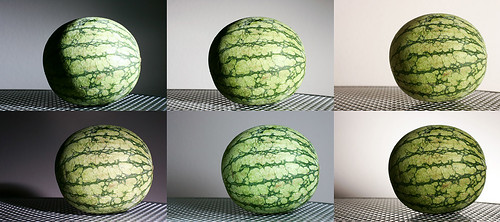lighting: apparent size
Okay, let's keep the excitement building for a while with some shots of melons. Or at least one watermelon, multiple times. The principle I'm playing with here is how the apparent size of the light source can dramatically change the shadows. In particular, it changes the transition zone from the highlight to the shadows.
Again the camera and subject are fixed and I'm just changing the lightsource. Each time it is just one flash, sometimes zoomed in on a narrow beam and directed straight at the melon (top left). Next I widen the beam with the zoom controls on the flash head (top middle shot) After that I start diffusing it in different ways. The top right shot has the light firing in to a large white ball that acts as a diffuser (and tints the light slightly warmer).
For the bottom row, I put the flash head in a silver umbrella. Here I vary how far away the umbrella and flash is from the melon. Bottom left the umbrella is quite far away - so again the shadows are quite well defined, but with a softer fall off as the light is still much larger than just the bare flash head. The bottom middle shot I've moved the umbrella closer in, giving a much more wrap around, even light with very diffused shadows. Finally, I put a gobo (a sheet of paper) in between the umbrella and the melon - everything else is well illuminated but the translucent paper knocks down the amount of light hitting the melon - the background ends up brighter as a result.





2 comments:
did you have the white balance constant?
I wasn't paying a whole lot of attention the white balance for these, I pretty much let it land where it wanted to in auto white balance mode, hence some of the shifts between the versions.
Post a Comment